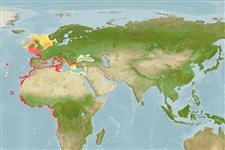Classificação / Names
Common names from other countries
Referência principal
Tamanho / Peso / Idade
Max length : 36.0 cm TL macho/indeterminado; (Ref. 3397); common length : 20.0 cm TL macho/indeterminado; (Ref. 3397)
Length at first maturity
Lm 14.3 range ? - ? cm
Ambiente
; marinhas demersal; oceanódromo (Ref. 51243); intervalo de profundidade 0 - 350 m (Ref. 26999), usually 0 - 100 m (Ref. 26999)
Clima / Intervalo
Subtropical, preferred 21°C (Ref. 107945); 63°N - 16°S, 26°W - 42°E (Ref. 54286)
Distribuição
Eastern Atlantic: Norway to Angola, including the Canary Islands, Cape Verde, and the Sao Tome-Principe Islands. Common from Bay of Biscay to Gibraltar (Ref. 4781). Also found in the Mediterranean and the Black Sea.
Países | Áreas FAO | Ecossistemas | Ocorrências | Introduções
Descrição breve
Espinhos dorsais (total): 13 - 15; Raios dorsais moles (total): 12-16; Espinhos anais 3; Raios anais moles: 14 - 16. Body slender, with 3 - 5 weak, golden longitudinal stripes and a black spot at the pectoral fin base (Ref. 35388).
Categoria na Lista Vermelha da IUCN (Ref. 115185)
Ameaça para o homem
Harmless
Utilização humana
Pescarias: altamente comercial; peixe desportivo: sim; isco: usually
Ferramentas
Relatórios especiais
Descarregue XML
Fontes da internet
Estimates of some properties based on models
Phylogenetic diversity index
PD50 = 0.7500 many relatives (e.g. carps) 0.5 - 2.0 few relatives (e.g. lungfishes)
Nível Trófico
2.8 ±0.0 se; Based on diet studies.
Resiliência
Médio, tempo mínimo de duplicação da população 1,4 - 4,4 anos (K=0.16-0.4; tm=1-2; Fec=395,000)
Vulnerabilidade
Moderate to high vulnerability (49 of 100)
Categoria de preço
